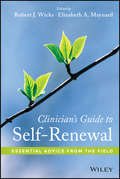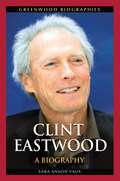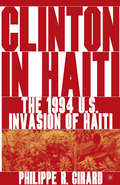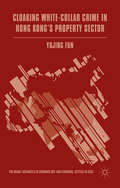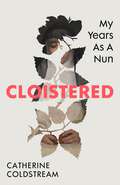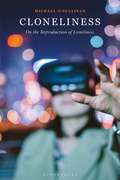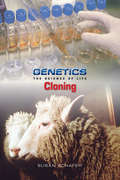- Table View
- List View
A Clinician’s Guide to Gender Identity and Body Image: Practical Support for Working with Transgender and Gender-Expansive Clients
by Heidi Dalzell Kayti ProtosThis accessible guide for clinicians and clinical students working in the fields of eating disorders and transgender health psychology offers useful tips, constructive case studies and reflective questions that enable readers to feel better equipped in supporting their clients' needs.The book addresses the clinical challenges a therapist may encounter, and provides advice on the key issues involved in therapeutic work with transgender, non-binary and gender-expansive clients, including trauma, minority stress, coming out, family support, appearance and body changes. This book will inspire clinicians to bridge the disconnect between the clinical criteria for eating disorders and the type of eating disorder manifesting in a client with co-occurring gender dysphoria.
A Clinician’s Guide to Gender Identity and Body Image: Practical Support for Working with Transgender and Gender-Expansive Clients
by Heidi Dalzell Kayti ProtosThis accessible guide for clinicians and clinical students working in the fields of eating disorders and transgender health psychology offers useful tips, constructive case studies and reflective questions that enable readers to feel better equipped in supporting their clients' needs.The book addresses the clinical challenges a therapist may encounter, and provides advice on the key issues involved in therapeutic work with transgender, non-binary and gender-expansive clients, including trauma, minority stress, coming out, family support, appearance and body changes. This book will inspire clinicians to bridge the disconnect between the clinical criteria for eating disorders and the type of eating disorder manifesting in a client with co-occurring gender dysphoria.
Clinician's Guide to Self-Renewal: Essential Advice from the Field
by Robert J. Wicks Elizabeth A. MaynardProviding clinicians with advice consistent with the current emphasis on working from strengths to promote renewal, this guide presents a holistic approach to psychological wellness. Time-tested advice is featured from experts such as Craig Cashwell, Jeffrey Barnett, and Kenneth Pargament. With strategies to renew the mind, body, spirit, and community, this book equips clinicians with guidance and inspiration for the renewal of body, mind, community, and spirit in their clients and themselves.
Clinician's Guide to Self-Renewal: Essential Advice from the Field
by Robert J. Wicks Elizabeth A. MaynardProviding clinicians with advice consistent with the current emphasis on working from strengths to promote renewal, this guide presents a holistic approach to psychological wellness. Time-tested advice is featured from experts such as Craig Cashwell, Jeffrey Barnett, and Kenneth Pargament. With strategies to renew the mind, body, spirit, and community, this book equips clinicians with guidance and inspiration for the renewal of body, mind, community, and spirit in their clients and themselves.
Clinician's Guide to Severe Hoarding: A Harm Reduction Approach
by Michael A. TompkinsThe cat lady. The couple who won't let anyone in their apartment. The old man with all that junk in his yard. Their severe hoarding puts them, and often others, at risk for injury, disease, and even death. Most deny needing help, and for this reason, professionals are desperate to find more effective ways to offer and provide assistance to them.In response to this growing public health problem, Clinician's Guide to Severe Hoarding refines our understanding and presents in depth and innovative alternative to traditional interventions. Arguing that although treatment for hoarding can be effective for those who are open to help, people with severe hoarding are not. The Clinician’s Guide to Severe Hoarding describes an alternative strategy to help those who adamantly refuse help and yet face significant health and safety risks due to the hoarding problem – harm reduction. This client-centered approach takes readers through harm reduction plan development, team building, goal setting, client collaboration, and progress assessment. The Clinician’s Guide also explains that a successful harm reduction plan may encourage clients to seek further help, and offers insights into working with special populations such as people who hoard animals and children who exhibit hoarding behavior. The Clinician's Guide describes in detail a range of strategies for assisting people with severe hoarding: Strategies for engaging with clients who hoard.Guidelines for assessing harm potential.Guidelines for creating a harm reduction plan, building a harm reduction team, and conducting and evaluating home visits.Skills for client self-help: decision making, time management, and more.Guidelines for navigating the ethical and legal issues that arise in assisting people who hoard.Readings, links, and other resources.With its practical common-sense approach to a complex problem, Clinician's Guide to Severe Hoarding is a unique volume not only for mental health practitioners, but also other professionals who assist people who hoard, such as home health aides, social workers, and professional organizers.
Clint Eastwood: Evolution of a Filmmaker (Modern Filmmakers)
by John H. FooteNow a two-time Academy Award winner for best director, twice winner of the Directors Guild of America Award for best director, and recipient of countless other critics prizes and nominations in multiple capacities, Clint Eastwood stands alongside Martin Scorsese and Steven Spielberg as one of the finest directors working in modern cinema. Here, John Foote examines the long, impressive, and unlikely film career of a man who fought against expectations to forge his own way and become one of this generation's finest filmmakers. Each chapter examines a different film, beginning with Play Misty for Me (1971) and High Plains Drifter (1973) and extending to his 21st-century films Space Cowboys (2000), Blood Work (2002), Mystic River (2003), Million Dollar Baby (2004), Flags of Our Fathers (2006), Letters from Iwo Jima (2006), and Changeling (2008). This book is, in the author's own words, a study of how Eastwood managed to quietly get to this level—and a celebration of his gifts as an artist. Eastwood has evolved not only as a director, but also as an actor, a screenwriter, a producer, and a score composer, to become one of the most revered figures in Hollywood.Perhaps it is because he started out in Hollywood with such little influence on the final product that he now demonstrates such a strong desire to collaborate with others and provide help wherever he can. In addition to casting off his reputation as a hack and accumulating two Oscar nominations for Best Actor over the past 15 years, he has guided other actors to no less than three Academy Award wins. The executives love him because he has made them money over the years—occasionally even making one for them in exchange for financial backing on other projects. Critics love him because of the care he takes in creating his films. Audiences love him because he has never lost his sense of entertainment, even as his artistry has matured.
Clint Eastwood: A Biography (Greenwood Biographies)
by Sara Anson Ph.D.Clint Eastwood—actor, director, composer, musician, and politician—is undeniably one of the most prolific and accomplished celebrities of the modern age. This book provides insights into Eastwood's life and entire career, from early television appearances to recent award-winning films.He established himself early in his acting career as "the strong silent type" and became known as the "actor's director." In a career that spans seven decades, Eastwood's work has been influential for multiple generations of film audiences as well as actors, directors, and producers. This biography investigates the man who made his characters' lines such as "Go ahead—make my day" and "Get off my lawn" unforgettable, and shows why his movie roles and the films he directed are honored, studied, quoted, and remembered.The book describes everything from Eastwood's formative years and early days as a struggling actor to his family and personal life to his lifelong love of jazz music and his political leanings. The chapters describe not only his tremendous accomplishments and countless successes but also his notable failures—coverage that will intrigue readers interested in the film industry, in the acting craft, and in enduring popular cultural icons.
Clint Eastwood: A Biography (Greenwood Biographies)
by Sara Anson Ph.D.Clint Eastwood—actor, director, composer, musician, and politician—is undeniably one of the most prolific and accomplished celebrities of the modern age. This book provides insights into Eastwood's life and entire career, from early television appearances to recent award-winning films.He established himself early in his acting career as "the strong silent type" and became known as the "actor's director." In a career that spans seven decades, Eastwood's work has been influential for multiple generations of film audiences as well as actors, directors, and producers. This biography investigates the man who made his characters' lines such as "Go ahead—make my day" and "Get off my lawn" unforgettable, and shows why his movie roles and the films he directed are honored, studied, quoted, and remembered.The book describes everything from Eastwood's formative years and early days as a struggling actor to his family and personal life to his lifelong love of jazz music and his political leanings. The chapters describe not only his tremendous accomplishments and countless successes but also his notable failures—coverage that will intrigue readers interested in the film industry, in the acting craft, and in enduring popular cultural icons.
Clint Eastwood's America (America Through the Lens)
by Sam B. GirgusThe steady rise of Clint Eastwood’s career parallels a pressing desire in American society over the past five decades for a figure and story of purpose, meaning, and redemption. Eastwood has not only told and filmed that story, he has come to embody it for many in his public image and film persona. Eastwood responds to a national yearning for a vision of individual action and initiative, personal responsibility, and potential for renewal. An iconic director and star for his westerns, urban thrillers, and adventure stories, Eastwood has taken film art to new horizons of meaning in a series of masterpieces that engage the ethical and moral consciousness of our times, including Unforgiven, Million Dollar Baby, and Mystic River. He revolutionized the war film with the unprecedented achievement of filming the opposing sides of the same historic battle in Flags of Our Fathers and Letters from Iwo Jima, using this saga to present a sharply critical representation of the new America that emerged out of the war, a society of images and spectacles. This timely examination of Clint Eastwood’s oeuvre against the backdrop of contemporary America will be fascinating reading for students of film and popular culture, as well as readers with interests in Eastwood’s work, American film and culture.
Clint Eastwood's America (America Through the Lens)
by Sam B. GirgusThe steady rise of Clint Eastwood’s career parallels a pressing desire in American society over the past five decades for a figure and story of purpose, meaning, and redemption. Eastwood has not only told and filmed that story, he has come to embody it for many in his public image and film persona. Eastwood responds to a national yearning for a vision of individual action and initiative, personal responsibility, and potential for renewal. An iconic director and star for his westerns, urban thrillers, and adventure stories, Eastwood has taken film art to new horizons of meaning in a series of masterpieces that engage the ethical and moral consciousness of our times, including Unforgiven, Million Dollar Baby, and Mystic River. He revolutionized the war film with the unprecedented achievement of filming the opposing sides of the same historic battle in Flags of Our Fathers and Letters from Iwo Jima, using this saga to present a sharply critical representation of the new America that emerged out of the war, a society of images and spectacles. This timely examination of Clint Eastwood’s oeuvre against the backdrop of contemporary America will be fascinating reading for students of film and popular culture, as well as readers with interests in Eastwood’s work, American film and culture.
Clinton in Haiti: The 1994 US Invasion of Haiti
by P. GirardThe book focuses on Aristide's political career, emphasizing his strategizing, compromising and dealing with the Clinton administration. In his presentation of the conflict, Girard carefully balances Aristide's and Clinton's needs, and the demands and moral positions the leaders make against each other - the result is that each leader and his constituency comes to life, and their maneuverings and decisions become engaging and meaningful. While Girard focuses on the conflict itself and the foreign policy dynamics at play between Haiti and the US, he also paints a compelling picture of contemporary Haiti and delineates with great clarity the tensions which led to recent violence and the deposition of Aristide.
Clio/Anthropos: Exploring the Boundaries between History and Anthropology
by Eric Tagliacozzo, Andrew WillfordThe intersection between history and anthropology is more varied now than it has ever been—a look at the shelves of bookstores and libraries proves this. Historians have increasingly looked to the methodologies of anthropologists to explain inequalities of power, problems of voicelessness, and conceptions of social change from an inside perspective. And ethnologists have increasingly relied on longitudinal visions of their subjects, inquiries framed by the lens of history rather than purely structuralist, culturalist, or functionalist visions of behavior. The contributors have dealt with the problems and possibilities of the blurring of these boundaries in different and exciting ways. They provide further fodder for a cross-disciplinary experiment that is already well under way, describing peoples and their cultures in a world where boundaries are evermore fluid but where we all are alarmingly attached to the cataloguing and marking of national, ethnic, racial, and religious differences.
Clio in the Classroom: A Guide for Teaching U.S. Women's History
by Carol Berkin Margaret S. Crocco Barbara WinslowOver the last four decades, women's history has developed from a new and marginal approach to history to an established and flourishing area of the discipline taught in all history departments. Clio in the Classroom makes accessible the content, key themes and concepts, and pedagogical techniques of U.S. women's history for all secondary school and college teachers. Editors Carol Berkin, Margaret S. Crocco, and Barbara Winslow have brought together a diverse group of educators to provide information and tools for those who are constructing a new syllabus or revitalizing an existing one. The essays in this volume provide concise, up-to-date overviews of American women's history from colonial times to the present that include its ethnic, racial, and regional changes. They look at conceptual frameworks key to understanding women's history and American history, such as sexuality, citizenship, consumerism, and religion. And they offer concrete approaches for the classroom, including the use of oral history, visual resources, material culture, and group learning. The volume also features a guide to print and digital resources for further information. This is an invaluable guide for women and men preparing to incorporate the study of women into their classes, as well as for those seeking fresh perspectives for their teaching.
Clio in the Classroom: A Guide for Teaching U.S. Women's History
by Carol Berkin, Margaret S. Crocco And Barbara WinslowOver the last four decades, women's history has developed from a new and marginal approach to history to an established and flourishing area of the discipline taught in all history departments. Clio in the Classroom makes accessible the content, key themes and concepts, and pedagogical techniques of U.S. women's history for all secondary school and college teachers. Editors Carol Berkin, Margaret S. Crocco, and Barbara Winslow have brought together a diverse group of educators to provide information and tools for those who are constructing a new syllabus or revitalizing an existing one. The essays in this volume provide concise, up-to-date overviews of American women's history from colonial times to the present that include its ethnic, racial, and regional changes. They look at conceptual frameworks key to understanding women's history and American history, such as sexuality, citizenship, consumerism, and religion. And they offer concrete approaches for the classroom, including the use of oral history, visual resources, material culture, and group learning. The volume also features a guide to print and digital resources for further information. This is an invaluable guide for women and men preparing to incorporate the study of women into their classes, as well as for those seeking fresh perspectives for their teaching.
Clio's Foot Soldiers: Twentieth-Century U.S. Social Movements and Collective Memory (Public History in Historical Perspective)
by Lara Leigh KellandCollective memories are key to social movements. Activists draw on a shared history to build identity, create movement cohesion, and focus political purpose. But what happens when marginalized communities do not find their history in dominant narratives? How do they create a useable past to bind their political communities together and challenge their exclusion? In Clio's Foot Soldiers, Lara Leigh Kelland investigates these questions by examining 1960s and 1970s social movements comprised of historically marginalized peoples: Civil Rights, Black Power, Women's and Gay Liberation, and American Indian. These movements sought ownership over their narratives to create historical knowledge reflective of their particular experiences. To accomplish their goals, activists generated new forms of adult education, published movement newspapers, and pursued campus activism and speeches, public history efforts and community organizations. Through alternative means, marginalized communities developed their own historical discourses to mobilize members, define movement goals, and become culturally sovereign. In so doing, they provided a basis for achieving political liberation and changed the landscape of liberal cultural institutions.
Cloak of Charity: Studies in Eighteenth-Century Philanthropy (Routledge Revivals)
by Betsy RodgersFirst published in 1949, Cloak of Charity provides a short history of philanthropy in the eighteenth-century. The author asserts that the history of charity is the history of the changes which have occurred in the attitude of the rich towards the poor. The character of philanthropy changed considerably during the course of the eighteenth-century and it is this change that the book traces. This book will be of interest to students of history, sociology and religion.
Cloak of Charity: Studies in Eighteenth-Century Philanthropy (Routledge Revivals)
by Betsy RodgersFirst published in 1949, Cloak of Charity provides a short history of philanthropy in the eighteenth-century. The author asserts that the history of charity is the history of the changes which have occurred in the attitude of the rich towards the poor. The character of philanthropy changed considerably during the course of the eighteenth-century and it is this change that the book traces. This book will be of interest to students of history, sociology and religion.
Cloaking White-Collar Crime in Hong Kong's Property Sector (Palgrave Advances in Criminology and Criminal Justice in Asia)
by Yujing FunHong Kong's anti-corruption agency, ICAC, is hailed as among the world's best having almost completely purged systemic corruption within a decade of its inception. This book explains how Hong Kong maintains the myth of a clean city and examines the prevalence of white collar crime in the city's property sector.
The Clock Mirage: Our Myth of Measured Time
by Joseph MazurA tour of clocks throughout the centuries—from the sandglass to the telomere—to reveal the physical, biological, and social nature of time What is time? This question has fascinated philosophers, mathematicians, and scientists for thousands of years. Why does time seem to speed up with age? What is its connection with memory, anticipation, and sleep cycles? Award-winning author and mathematician Joseph Mazur provides an engaging exploration of how the understanding of time has evolved throughout human history and offers a compelling new vision, submitting that time lives within us. Our cells, he notes, have a temporal awareness, guided by environmental cues in sync with patterns of social interaction. Readers learn that, as a consequence of time’s personal nature, a forty-eight-hour journey on the Space Shuttle can feel shorter than a six-hour trip on the Soyuz capsule, that the Amondawa of the Amazon do not have ages, and that time speeds up with fever and slows down when we feel in danger. With a narrative punctuated by personal stories of time’s effects on truck drivers, Olympic racers, prisoners, and clockmakers, Mazur’s journey is filled with fascinating insights into how our technologies, our bodies, and our attitudes can change our perceptions. Ultimately, time reveals itself as something that rides on the rhythms of our minds. The Clock Mirage presents an innovative perspective that will force us to rethink our relationship with time, and how best to use it.
Clocking the Mind: Mental Chronometry and Individual Differences
by Arthur R. JensenMental Chronometry (MC) comprises a variety of techniques for measuring the speed with which the brain processes information.First developed in mid-1800, MC was subsequently eclipsed by more complex and practically useful types of psychometric tests stemming from Alfred Binet. This class of mental tests, however, has no true metric relating the test scores to any specific properties of the brain per se. The scores merely represent an ordinal scale, only ranking individuals according to their overall performance on a variety of complex mental tasks. The resulting scores represent no more than ranks rather than being a true metrical scale of any specific dimension of brain function. Such an ordinal scale, which merely ranks individuals in some defined population, possesses no true scale properties, possessing neither a true zero or equal intervals throughout the scale. This deficiency obstructs the development of a true natural science of mental ability. The present burgeoning interest in understanding individual differences in mental abilities in terms of the natural sciences, biology and the brain sciences in particular, demands direct measures that functionally link brain and behavior. One such natural ratio scale is time itself - the time it takes the brain to perform some elementary cognitive task, measured in milliseconds. After more than 25 years researching MC, Jensen here presents results on an absolute scale showing times for intake of visual and auditory information, for accessing short-term and long-term memory, and other cognitive skills, as a function of age, at yearly intervals from 3 to 80 years. The possible uses of MC in neurological diagnosis and the monitoring of drug effects on cognition, the chronometric study of special time-sensitive talents such as musical performance, and presents a theory of general intelligence, or g, as a function of the rate of oscillation of neural action potentials as measured by chronometric methods. Finally, Jensen urges the world-wide standardization of chronometric methods as necessary for advancing MC as a crucial branch of biopsychological science.Provides a different scale to report Mental Chronometry (MC) findingsArgues for the global adoption of an absolute scale as opposed to the traditional ordinal scaleAn important contribution to MC researchers and psychologists and neuroscientists
Cloistered: ‘[A] beautifully written memoir…evolves into a spiritual thriller’ Observer
by Catherine Coldstream'A profoundly moving memoir which gripped me' Mark HaddonDiscover Catherine Coldstream’s evocative account of life as a nun in the 1990s, and the dramatic events which led to her flight from the monastery.After the shock of her father’s death, twenty-four-year-old Catherine was left grieving and alone. A search for meaning led her to Roman Catholicism and the nuns of Akenside Priory.Here she found a tight-knit community of dedicated women and peace in an ancient way of life. But as she surrenders to her final vows, all is not as it seems behind the Priory’s closed doors. Power struggles erupt – with far-reaching consequences for those within.Catherine comes to realise that divine authority is mediated through flawed and all-too-human channels. She is faced with a dilemma: should she protect the serenity she has found, or speak out?A love song to a lost community and an honest account of her twelve years in the Order, Cloistered is also a cautionary tale about what can happen when good people cut themselves off from the wider world.‘Immersive, beautifully observed’ Katherine May'I admired [Cloistered] enormously' Sarah Perry‘An intense and often theatrical read’ Financial Times
Cloneliness: On the Reproduction of Loneliness
by Michael O'SullivanRecent posthuman philosophies, human-computer interface studies, and technology-inspired biopolitical discourses and practices are reinventing and reimagining loneliness in different communities. Cloneliness: The Reproduction of Loneliness takes a cross-cultural approach to loneliness by examining 20th-century artistic expressions and examinations of loneliness in the context of more recent global expressions grounded in social networks, virtual reality, the biopolitical commons, academic credentialization and such practices as Hikikomori. Newer forms of loneliness, pushed by the algorithms of biopolitical capitalism, result in what this books calls "cloneliness." Michael O'Sullivan plots the transformation in loneliness in literature and philosophy in readings that take us from Henry James and such classic works as Frank O'Connor's The Lonely Voice and Richard Yates's Eleven Kinds of Loneliness to more recent expressions in such writers as David Foster Wallace, Yiyun Li, and Sayaka Murata.Michael O'Sullivan argues that cloneliness as an institutional practice of reproduction in society nurtures, normalizes, and reproduces loneliness in order to create subjects who are more willing to accept ideologies of competition, “extreme individualism,” and the stresses of being "interconnected loners."
Cloneliness: On the Reproduction of Loneliness
by Michael O'SullivanRecent posthuman philosophies, human-computer interface studies, and technology-inspired biopolitical discourses and practices are reinventing and reimagining loneliness in different communities. Cloneliness: The Reproduction of Loneliness takes a cross-cultural approach to loneliness by examining 20th-century artistic expressions and examinations of loneliness in the context of more recent global expressions grounded in social networks, virtual reality, the biopolitical commons, academic credentialization and such practices as Hikikomori. Newer forms of loneliness, pushed by the algorithms of biopolitical capitalism, result in what this books calls "cloneliness." Michael O'Sullivan plots the transformation in loneliness in literature and philosophy in readings that take us from Henry James and such classic works as Frank O'Connor's The Lonely Voice and Richard Yates's Eleven Kinds of Loneliness to more recent expressions in such writers as David Foster Wallace, Yiyun Li, and Sayaka Murata.Michael O'Sullivan argues that cloneliness as an institutional practice of reproduction in society nurtures, normalizes, and reproduces loneliness in order to create subjects who are more willing to accept ideologies of competition, “extreme individualism,” and the stresses of being "interconnected loners."
Cloning: The Science Of Life
by Susan SchaferThis book provides in-depth explorations of genetic cloning, including the history of cloning and the types of artificial cloning for both plants and animals, with fascinating examples. It also explains the possibility of using the gene therapy to cure diseases.
Cloning
by Susan SchaferThis book provides in-depth explorations of genetic cloning, including the history of cloning and the types of artificial cloning for both plants and animals, with fascinating examples. It also explains the possibility of using the gene therapy to cure diseases.

